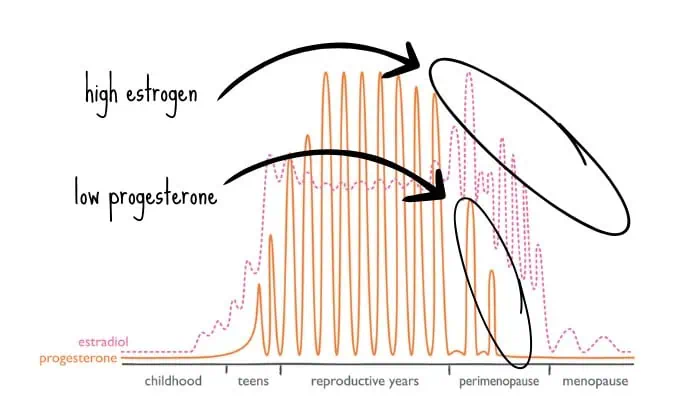
Night sweats, mood swings, and crazy heavy periods. Is this menopause already? And you’re only 42? No, menopause could still be a decade away. This is perimenopause or second puberty, which is the decade or so before your final period.
Perimenopause is different from menopause (or post-menopause), which is the life phase that begins one year after your final period.
From a hormonal perspective, perimenopause is very different from menopause in that during the early phases of perimenopause, estrogen goes up, not down.

Estrogen goes on a roller coaster ride
Starting from your late thirties, your estrogen could fluctuate and soar to higher than when you were younger—only to crash down again to almost nothing. Over and over again, month after month. I call this the estrogen roller coaster of perimenopause.
Symptoms of high estrogen include breast pain, heavy periods, fluid retention, irritable mood, and (in some cases) a histamine or mast cell reaction.
Symptoms of dropping estrogen, or estrogen withdrawal, include depression, weight gain, hot flashes, and night sweats.

Progesterone quietly exits the scene
At the same time your estrogen is crashing up and down, progesterone quietly exits the scene—which is unfortunate because progesterone could have sheltered your nervous system from the turbulent ups and downs of estrogen.
Progesterone drops with perimenopause because progesterone is hard to make. Unlike estrogen (which you make on the way to ovulation), progesterone can only be made after ovulation. And ovulation is hard to do, especially as you move into your forties and start to have shorter luteal phases and more anovulatory cycles.
Symptoms of low progesterone include insomnia, heavy periods, and frequent migraines.
How to feel better in your forties
Stabilize your nervous system with magnesium and the amino acid taurine—two nutrients that can relieve hot flashes and improve sleep.
Reduce histamine and mast cell activation to relieve symptoms.
Prevent estrogen from spiking too high by reducing alcohol, supporting a healthy gut microbiome, and taking supplements such as iodine and calcium-D-glucarate. Read How to lower estrogen.
Take bioidentical or body-identical progesterone (brand names Prometrium or Utrogestan), which can relieve symptoms of estrogen excess and estrogen withdrawal. Progesterone also stabilizes the HPA (adrenal) axis and supports thyroid function. Read Guide to using progesterone for women’s health.
For more, check out my book Hormone Repair Manual: every woman’s guide to healthy hormones after 40.
